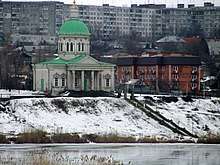Museum of Russian-Armenian Friendship

The Museum of Russian-Armenian Friendship is a museum in Rostov-on-Don, located in the Armenian church of Surb Khach (now in the Iskandarov House). The museum was opened on November 14, 1972. The church of Surb Khach, in which the museum was located, is one of the surviving buildings of the pre-existing monastery. It was built in the late 18th century by Armenian settlers from the Crimea in memory of the monastery of the same name in the Crimea. The building of the church is the oldest building in Rostov-on-Don.[1]
The museum address is: 344113, Rostov Region, Rostov-on-Don, ul. Bagramyan, 1 (Rostov-on-Don, Svobody square, 14)[2]
Description
The Museum of Russian-Armenian Friendship was located until 2007 in the building of the church of Surb Khach (Holy Cross), later - in the building of Iskandarov. The building of the church is a cultural monument of the XVIII century of national importance. From 1790 to 1796 on the territory of the monastery of Surb Khacha worked one of the first printing houses in the south of Russia.
Famous people are buried in the monastery of Surb Khach: the teacher Harutyun Manukovich Alamdaryan, the poet Mikael Lazarevich Nalbadyan, and Rafael Gabrielovich Patkanyan.
The exhibition "Christian Apostolic Church on the Don" dedicated to the 1700th anniversary of the adoption of Christianity by Armenia works in the museum. The Bust of Mikael Nalbandyan and Bust of Raphael Patkanyan are i the collection of the museum
In 1968-1972, the monastery carried out restoration work on the project of Mark Grigoryan. In 1972, after the restoration, in the building of the temple was opened the Rostov Museum of Russian-Armenian Friendship, in which more than 30 thousand items. Since 2000, worship services have been held in the church of the monastery [1] [3]. In the exposition of the museum there are objects of everyday life of the XVIII century, Armenian books of the XVIII century, materials about the life and work of the writer Rafael Patkanyan and others.
The most valuable collection of the museum is a collection of 47 items of copper utensils of the XVIII century, which was brought during the migration of Armenians from Crimea to the Don.
The Surb Khach temple is located in the Northern residential area of Rostov-on-Don. The temple with the park is surrounded by a hedge and is located on the high right bank of the upper of the two northern reservoirs in the Temernik gully, to which it faces (south). To the east of the stone staircase from under the hill, on which the temple is located, there is a spring. Near the spring there is a bathing place and a recreation area. The bathing monastery is one of the traditional places of Rostov for Epiphany bathing.
The church is built in the style of classicism. Important elements in the composition of the building are porticoes, while the planes of the walls, in particular, the drum, are divided by pilasters and cornices. The church is rectangular in plan, with small rizalites in the middle part and with an apse protruding in the east.[3]
From the church to the river Temernik, a stone staircase descends, which earlier through two bridges led to the park, which was in the bend of the river. To the east of the church there is a tuning built in 1862 over the spring "Chorkhakh".
The main relic of the church is the cross-stone of the 6th century. Khachkar, according to legend, was taken from the ancient capital of Armenia - the city of Ani, and brought to the Don land in XVIII by Armenian settlers from the Crimea.
History
The Armenian Diaspora on the Don is the largest in Russia. The mass exodus of Armenians from Crimea to Rostov-on-Don and other southern cities of Russia occurred in the late 18th century. The first museum of friendship between Armenians and Russians was opened in 1972 on the territory of the monastery of Surb Khach. The creation of the monastery was supported by the artist Martiros Saryan. In 2010, the museum moved to the historical building of the two-story mansion of merchant M. Iskidarov. The building was built in 1899-1900 by architect S. K. Laskanov. The building is an architectural monument.
The church of the monastery of Surb Khach was laid in 1783, and construction began in 1786 and lasted for 6 years. November 27, 1792 the church was consecrated.
In 1862, near the western facade of the church was built a two-tiered bell tower with a high tetrahedral tent. To the east of the church was a two-story bishop's house. It housed the general school founded in 1791, later the seminary. There was a library at the seminary. In 1883 she was transported to Nakhichevan. The building housed a printing house that operated from 1790 to 1796. For 6 years here was printed about 20 books.[4] The belfry and the bishop's house were lost in the twentieth century.
The monastery operated until 1931, when the divine services were stopped, and the buildings were transferred to a local state farm under a granary.[5]
Literature
- Известия Ростовского областного музея краеведения. - Вып. 5. - 1988.
- Историко-краеведческий альманах. - Вып. 1. - Ростовское книжное издательство, 1991.
- Известия Ростовского областного музея краеведения. - Вып. 7. - 1977.
- Сурб Хач. Мемориальный комплекс: Буклет. - Ростов-на-Дону, 1990.
- Музей русско-армянской дружбы: Буклет. - Ростов-на-Дону, 1894.
References
- ↑ "Монастырь Сурб-Хач в Ростове-на-Дону возвращен Армянской Церкви / Новости / Патриархия.ru". Патриархия.ru (in Russian). Retrieved 2018-04-25.
- ↑ "Музей русско-армянской дружбы". Сайт Ростова (in Russian). Retrieved 2018-04-25.
- ↑ В.П. Грудев, Ю.Н. Солнышкин, А.В. Тарасов, М.А. Честнов. Проект реставрации б. церкви монастыря Сурб Хач. — Ростов-на-Дону, 1988.
- ↑ "Музей русско-армянской дружбы". www.museum.ru. Retrieved 2018-04-25.
- ↑ Вячеслав Грантович Вартанян. Саркис Суренович Казаров. История Армянской апостольской церкви на Дону (XVIII-XX вв.). — Изд-во Таганрог. ин-та упр., 2008. — 120 с.
External links
![]()